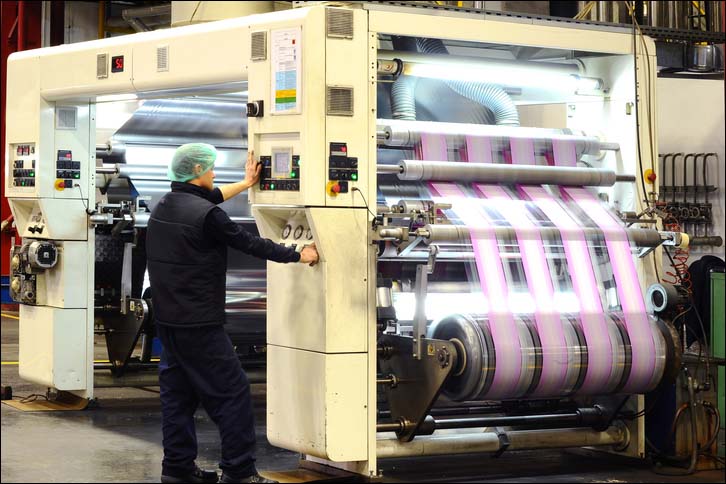 Web processing is unfamiliar to most people, even within the engineering profession. But, it is used in the manufacture of a remarkable range of products. Examples are: Web processing is unfamiliar to most people, even within the engineering profession. But, it is used in the manufacture of a remarkable range of products. Examples are:
Anything that is flexible enough to pass over rollers as semi-continuous strips and then be wound into rolls can be considered for web processing. Some typical materials are shown below. Left to right: Plastic grocery bag, Carpet, Flexible Packaging, Steel strip, Aluminum strip.
Web handling is "the physical mechanics related to the transport of continuous flexible materials (webs) through processes and machinery." The web is almost always supported on rollers and the processes (often referred to as roll-to-roll processes) include things such as printing, coating, laminating, curing, embossing and slitting. The field is divided into the following categories.
My attention has been focused mostly on lateral dynamics and control, including wrinkling and roller traction. Web handling gained recognition as an engineering discipline largely through the efforts of the Web Handling Research Center at Oklahoma State University, (WHRC). For thirty-three years, from 1986 to 2019, it created a growing body of knowledge that is currently used to solve web process problems that once required expensive trial and error experimenting. The key to understanding most web handling problems is knowing what the stresses in a web are doing to it. But, stress itself is very hard to see. Furthermore, it is very hard to measure in a thin moving web. Like anything else that has invisible causes, it's easy to make up plausible, but completely wrong theories (myths) about how stress produces problems. For example, before 1960 lots of web processors were completely confused about how misaligned rollers caused webs to shift laterally (and often wrinkle). One of the favorite myths was that "the web tracks to the tight side." In the middle of the twentieth century this and other mysteries began to get sorted out by small groups of researchers working in many different places. Prior to the WHRC much of the best work in web handling stayed in desk drawers at the companies where the work was done - companies like 3M, DuPont, Eastman Kodak and Beloit. But, in the 1980s some enlightened engineers (friends of mine - Dr. John Shelton, and Bruce Feiertag) recognized the need to coax this knowledge out into the open, where it could be organized and extended to create a recognized branch of process technology. This was something whose time had come, because by 1986, working with Dr. Karl Reid at Oklahoma State University, they had found enough like-minded people at major corporations to meet the corporate sponsorship requirements for a federal program to create the Web Handling Research Center (WHRC) at OSU. Beginning in 1991, the Center began sponsoring bi-annual IWEB conferences where serious researchers met, presented papers and discussed their latest work. The university has also graduated a number of students who earned their PhDs with web handling research projects conducted in the center's well-equipped lab. In addition to the difficulty caused by the invisibility of stress, the mechanics of web processes is much more complicated than one might expect. Webs will shift laterally at a misaligned roller and sometimes wrinkle. They may contract laterally when they encounter a roller that sags under the influence of tension and weight. Air is entrained between webs and roller sufaces at even modest speeds and can cause loss of traction - even to the point of completely losing contact with rollers. Air is also entrained between the layers of winding rolls, causing a variety of problems both during and after the winding process. Slipping can mar web surfaces. Web Handling Resources: The WHRC was an outstanding success. In its conference papers you will find most of what we presently know about web behavior. In fact, long-term participation in the WHRC's work has become the de facto credential for web handling expertise - a qualification possessed by all of the leading web handling consultants. Arrangements were made to archive proceedings from all fifeteen of the conferences at SHAREOK where they are available for downloading free of charge. Just type in IWEB as the search term to see what is available. Dave Roisum, a noted web Handling consultant, has created an extensive digital bibliography of Web Handling literature. You can access it through an app created by Dr. Steven Abbott at, Roisum Library. Here is a list of the papers from the 1993 WHRC International Conference on Web Handling that gives some sense of the range and depth of problems. Lateral Mechanics, Dynamics and Control
Longitudinal Mechanics, Dynamics and Control
Web Line Developments
Nip Mechanics
Winding Mechanics and Air Entrainment
Wrinkling
Spreading
Tension Measurement
|

